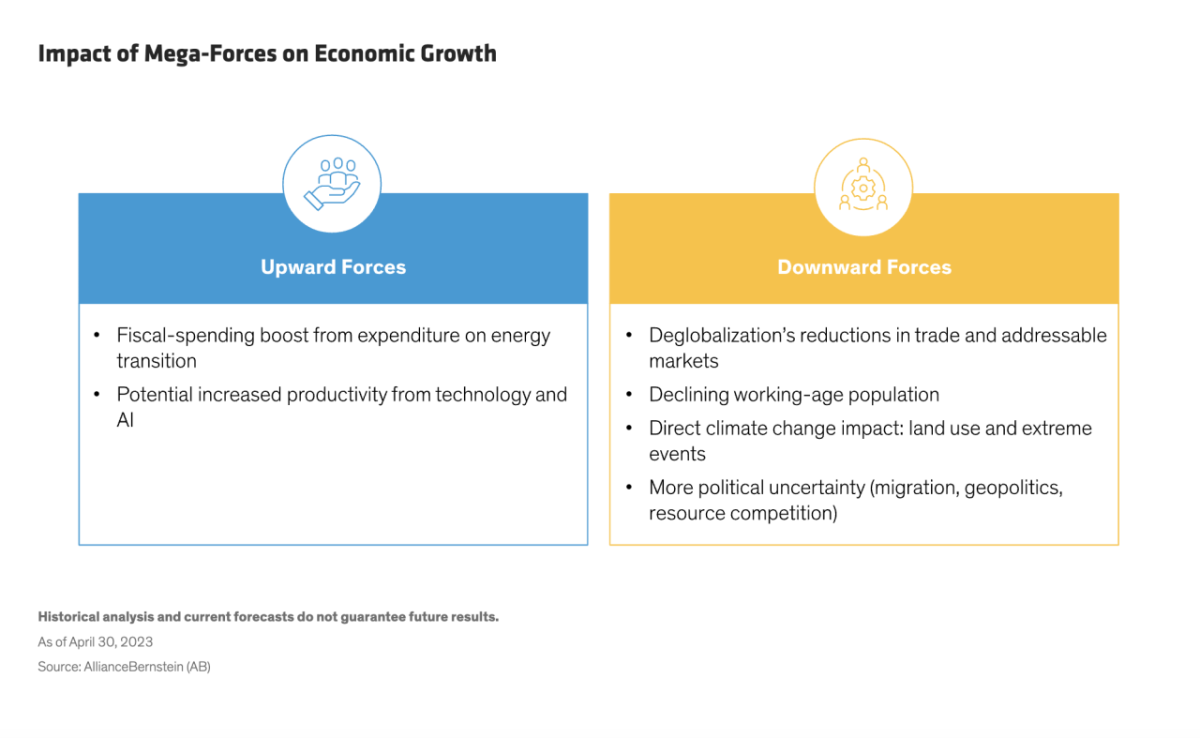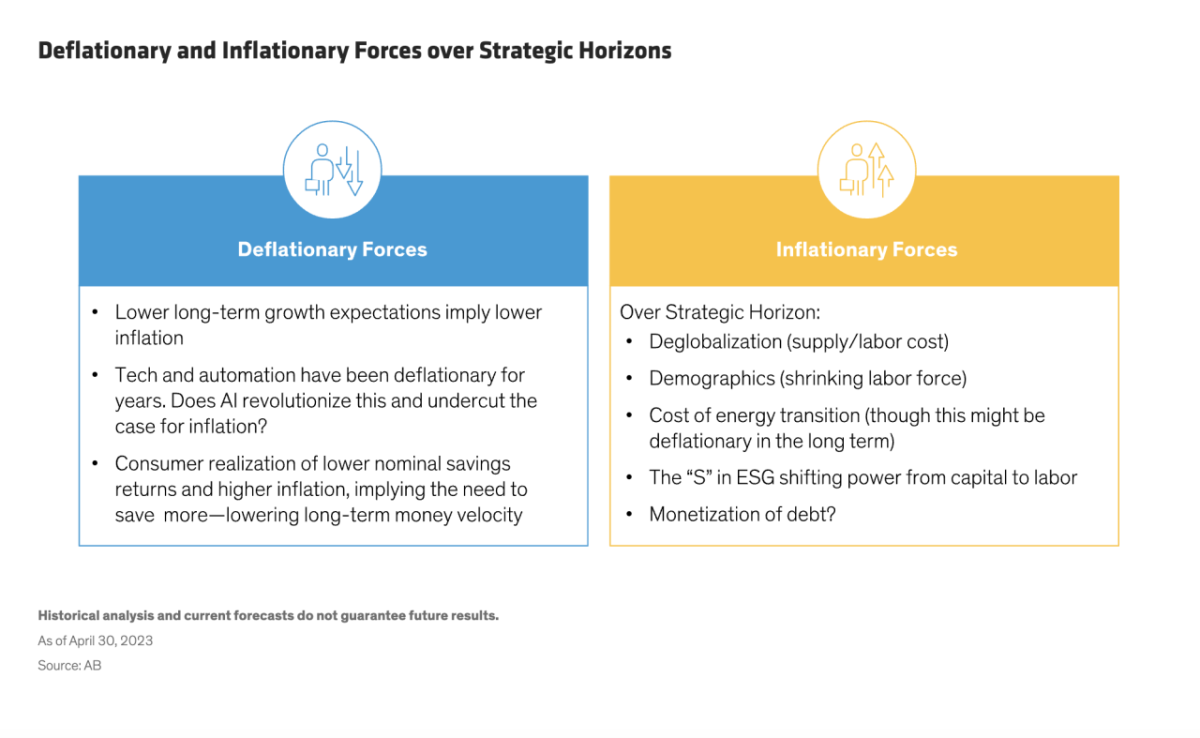AB: How Mega-Forces Will Reshape the Macro Regime and Investing
Published 04-25-24
Submitted by AllianceBernstein

Inigo Fraser Jenkins| Co-Head—Institutional Solutions
Alla Harmsworth| Co-Head—Institutional Solutions; Head—Alphalytics
Three mega-forces seem set to dominate the investment landscape for the next decade or longer, with major implications for the macro regime and portfolio design.
Each of these far-reaching forces—climate change, demographics and deglobalization—is significant in its own right. Where they’re likely to interact in a directionally similar way, they have the power to reshape financial outcomes, creating a new world for investors to navigate.
Macro Mega-Forces and the Impact on Economic Growth
Generally speaking, we think that one key implication of these mega-forces is a lower baseline level of economic growth. Here’s a brief overview of each force and how it could play into growth prospects.

Demographics: The global population of working-age people has peaked and is set to decline in coming decades. Boosting labor participation could help counter the decline, but a relatively small share of workers are in scope for extended careers, and efforts to raise retirement ages have been controversial.
Also, a growing need for long-term care could impair productivity by crowding out research and development or infrastructure spending while requiring a growing share of people engaged in the care sector, which doesn’t contribute to measurable growth. Artificial intelligence (AI) has the potential to boost productivity, which could help offset demographics.
Climate Change: The growth effect of climate change may be the hardest force to assess, given the diverse variables from rising temperatures to migration pressure and resource conflict. Focusing here on rising temperatures alone, accumulated research implies that this would likely depress growth, though with a very uneven impact across regions and countries—and a materially worse outcome for poor countries.
Could the response to climate change help growth too? One possible avenue is investment in the energy transition, including a sizable amount of government spending that could offset some extent of negative growth forces. However, research suggests that this impact would likely be smaller than some of the downward forces—and subject to sustained capital expenditures globally.
Deglobalization: The retreat of the long era of globalization will likely continue. There’s general dissatisfaction with globalization in the internal politics of developed economies, and relations between the US and China—two major global players—are hardening. This will likely push down on growth rates and corporate margins.
Deglobalization can affect growth through declining trade, a fragmenting of the global labor force and reduced capital mobility, along with possible secondary forces such as political instability and geopolitical conflict. Deglobalization would likely be tempered by a partial partitioning of countries into trade blocs, but overall it dampens the growth outlook.
We’re often asked whether the onset of AI could improve productivity enough to offset these macro forces. It might, but the impact would have to be at the top of the range of historical improvements under economic regimes. So, building in such expectations would take a significant step.

Higher Inflation Is Likely over a Strategic Horizon
In our view, all three mega-forces have direct implications for inflation, but both inflationary and deflationary forces are at work over strategic horizons (Display).
The impact of demographics is hotly debated, with Japan often cited as an example of the first country to see a rapid, sustained aging followed by deflation. But this example has been relatively isolated—in coming decades, nearly all regions should see such a demographic change.
Increased labor bargaining power from deglobalization and a greater focus on the social element of ESG imply a higher wage path. Deglobalization also increases inflation by reducing firms’ ability to engage in labor-cost arbitrage. And it unwinds aspects of the supply chain infrastructure that were developed in recent decades, a trend that increases input costs.
Climate change has a route to drive higher inflation through higher input costs to energy and the need to fund the global energy transition, though the impact may wane over time. Once the required infrastructure for renewable power generation has been installed, economies could become somewhat delinked from commodity prices.
AI introduces plausibly deflationary forces, but we maintain our view that equilibrium inflation will remain above the pre-pandemic level, given the influence of the other large macro forces at work that point to higher inflation.

The Link of the Government Debt Burden to Mega-Forces
In addition to the mega-forces we’ve described, there’s also the question of whether governments attempt to monetize their debt. Because this is a question of future policy decisions, we see it as somewhat apart from the other forces acting on inflation—but there is a link.
So far, the massive buildup of public-sector debt in developed economies hasn’t mattered, because the combination of favorable demographics and deglobalization has helped drive debt costs down. Now that the cost of debt has risen, sustainability could become a much bigger issue.
The debt/GDP ratio for developed economies is the same today as it was at the end of WWII. However, there was a need to rebuild the capital stock in that earlier era, and the population in these economies was much younger, so there was a way to grow out of the burden. That would seem much harder to do now, given the likely growth constraints. As a result, inflating away the debt problem might be the more attractive path out of this impasse.
Macro Volatility Likely to Retrace Higher
The pre-pandemic period saw an unusually large decline in the volatility of macro variables, especially with respect to inflation. If some of this decline was a result of globalization helping to cushion against inflation shocks, we would expect a retracing to a somewhat higher level of inflation volatility. GDP volatility has been more episodic but was still below the pre-pandemic average.
The forces we discuss imply a generally higher level of macro volatility. One reason is that governments will likely play a larger role in economies in the post-pandemic era. Also, migration can magnify political uncertainty, and there’s more risk of extreme weather events occurring. In the background, the end of the post-WWII US-led order implies more economic risk.
Margins Likely to Fall…and the US Stands to Lose More
Corporate profitability has been very high, especially in the US. There is somewhat of a cyclical element to this trend, but a likely structural component exists too. In the long run, we see no good societal reason why the higher margins of recent years (Display) should be maintained, though AI could delay the mean reversion.
Key influences are likely to include greater labor-bargaining power, rising effective corporate tax rates, the loss of efficiency and knowledge transfer due to declining global trade, and a fading of the flattening effect of mega-cap efficiency on cap-weighted corporate margins.
As a result, we expect the US after-tax profit share to decline back to its long-run average. Other regions and countries haven’t seen the same sustained increase in profit share, so the case for downward mean reversion is weaker elsewhere. Profit share is one area where the US has more to lose.

Expect Real Interest Rates to Remain Very Low
If real interest rates reflect expectations of future economic growth, our lower-growth outlook implies that real rates are set to remain low.
Could the retirement and savings drawdown of retiring Baby Boomers imply an upward rate path instead? We think that upward pressure may be offset somewhat by the younger cohorts’ greater need to save, wealth creation in Asia over the past four decades and the opening up of China’s economy. These economies have shown a very high propensity to save, which has plausibly pushed yields down.
There can clearly be very large cyclical fluctuations in real rates, with 2022 a recent case in point. However, from a strategic viewpoint, the possible forces collectively at work imply that—at the very least—investors should not expect a secular rise in real yields. On balance, our view is that they stay very low (Display).
Implications for Strategic Asset Allocation
An environment of higher (but not unanchored) inflation, lower economic growth, and lower margins isn’t a bearish conclusion for investors, but it demands a response in strategic asset allocation. For investors with known nominal liabilities, the yield increase over the last two years is an opportunity to de-risk. But investors who need to protect the purchasing power of liabilities would need to take on more risk.
In a baseline outcome, equities would still deliver a positive real return, despite lower real growth and margins. Higher inflation implies a greater need for other real assets versus a traditional 60/40, including inflation-protected bonds and physical real assets such as commodities, infrastructure and real estate. So, for investors who need to protect the purchasing power of their portfolio, equities should be an anchor position. Diversifiers and other return sources, such as private assets, can be added around stocks.
The good outcome represents a dampened return experience from the pre-pandemic era, albeit with somewhat lower growth and constraints on how much further risk premia can compress.
The hardest outcome is the bad scenario where inflation rises, real growth falls and risk premia rise—essentially stagflation, with neither equities nor nominal bonds enhancing portfolio returns. This implies the need for a more extreme shift into physical real assets, gold and inflation-protected bonds. We also think that factor strategies, such as free-cash-flow yield, should be considered.
The views expressed herein do not constitute research, investment advice or trade recommendations and do not necessarily represent the views of all AB portfolio-management teams. Views are subject to revision over time.
Learn more about AB’s approach to responsibility here.

AllianceBernstein
AllianceBernstein
AllianceBernstein (AB) is a leading global investment management firm that offers diversified investment services to institutional investors, individuals, and private wealth clients in major world markets.
To be effective stewards of our clients’ assets, we strive to invest responsibly—assessing, engaging on and integrating material issues, including environmental, social and governance (ESG) considerations into most of our actively managed strategies (approximately 79% of AB’s actively managed assets under management as of December 31, 2024).
Our purpose—to pursue insight that unlocks opportunity—describes the ethos of our firm. Because we are an active investment manager, differentiated insights drive our ability to design innovative investment solutions and help our clients achieve their investment goals. We became a signatory to the Principles for Responsible Investment (PRI) in 2011. This began our journey to formalize our approach to identifying responsible ways to unlock opportunities for our clients through integrating material ESG factors throughout most of our actively managed equity and fixed-income client accounts, funds and strategies. Material ESG factors are important elements in forming insights and in presenting potential risks and opportunities that can affect the performance of the companies and issuers that we invest in and the portfolios that we build. AB also engages issuers when it believes the engagement is in the best financial interest of its clients.
Our values illustrate the behaviors and actions that create our strong culture and enable us to meet our clients' needs. Each value inspires us to be better:
- Invest in One Another: At AB, there’s no “one size fits all” and no mold to break. We celebrate idiosyncrasy and make sure everyone’s voice is heard. We seek and include talented people with diverse skills, abilities and backgrounds, who expand our thinking. A mosaic of perspectives makes us stronger, helping us to nurture enduring relationships and build actionable solutions.
- Strive for Distinctive Knowledge: Intellectual curiosity is in our DNA. We embrace challenging problems and ask tough questions. We don’t settle for easy answers when we seek to understand the world around us—and that’s what makes us better investors and partners to our colleagues and clients. We are independent thinkers who go where the research and data take us. And knowing more isn’t the end of the journey, it’s the start of a deeper conversation.
- Speak with Courage and Conviction: Collegial debate yields conviction, so we challenge one another to think differently. Working together enables us to see all sides of an issue. We stand firmly behind our ideas, and we recognize that the world is dynamic. To keep pace with an ever changing world and industry, we constantly reassess our views and share them with intellectual honesty. Above all, we strive to seek and speak truth to our colleagues, clients and others as a trusted voice of reason.
- Act with Integrity—Always: Although our firm is comprised of multiple businesses, disciplines and individuals, we’re united by our commitment to be strong stewards for our people and our clients. Our fiduciary duty and an ethical mind-set are fundamental to the decisions we make.
As of December 31, 2024, AB had $792B in assets under management, $555B of which were ESG-integrated. Additional information about AB may be found on our website, www.alliancebernstein.com.
Learn more about AB’s approach to responsibility here.
More from AllianceBernstein

